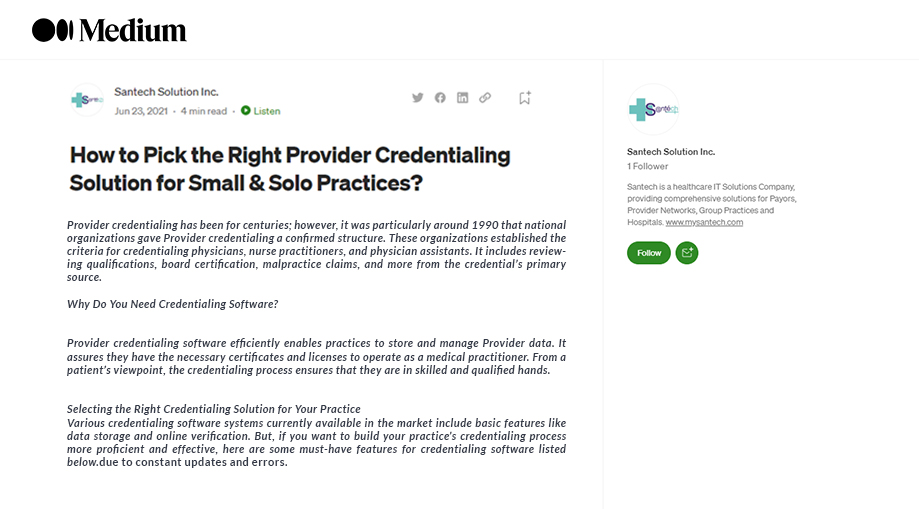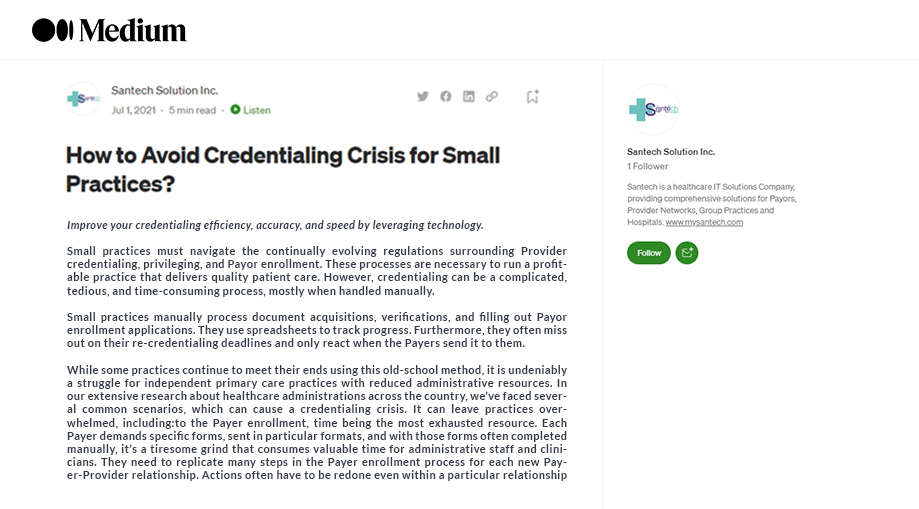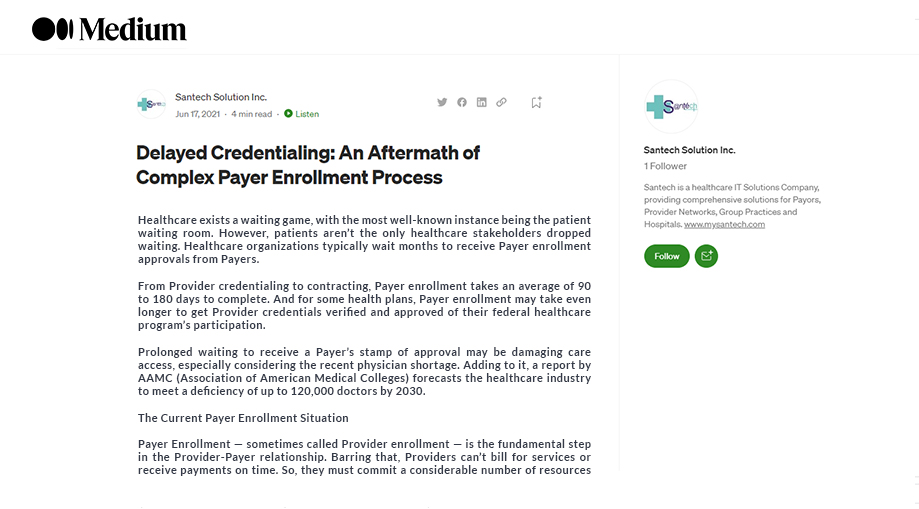
Provider credentialing has been for centuries; however, it was particularly around 1990 that national organizations gave Provider credentialing a confirmed structure. These organizations established the criteria for credentialing physicians, nurse practitioners, and physician assistants. It includes reviewing qualifications, board certification, malpractice claims, and more from the credential’s primary source.
Why Do You Need Credentialing Software?

Provider credentialing software efficiently enables practices to store and manage Provider data. It assures they have the necessary certificates and licenses to operate as a medical practitioner. From a patient’s viewpoint, the credentialing process ensures that they are in skilled and qualified hands.

Selecting the Right Credentialing Solution for Your Practice
Various credentialing software systems currently available in the market include basic features like data storage and online verification. But, if you want to build your practice’s credentialing process more proficient and effective, here are some must-have features for credentialing software listed below.
- Web-Based Accessibility
Accessibility will not be a problem if you choose a credentialing platform that stores data online. It should have a simple-to-use but intelligent “online file cabinet” that houses and protects all essential documents. It will guarantee that all the users — practice staff and the Providers — can manage the credentialing system on any digital tool with enhanced security.
- Third-Party Services Integration
A tailor-made Provider data management solution is seamlessly integrated with third-party services like NPPESS validation, Address validation service, E-Fax, and many more. It makes it simpler to share Provider data correctly and efficiently with many Payers at a stroke.
- Workflow Automation
The credentialing process involves:
o Collecting data from the healthcare Providers.
o Developing the credentialing strategy.
o Verifying the given credentials and licenses.
o Managing provider profiles.
o Getting in touch with Payers.
Customized credentialing solutions with automated workflows for verification, expiration management, onboarding options, credentialing metrics, and real-time, intuitive dashboards will substantially magnify productivity.
- Efficient Provider Communication
Practices applying the manual credentialing process face challenges in continually updating Provider information and credentials. A credentialing solution built per your requirements can help track the Provider’s profile. You can view and filter out the expiry Provider list and proactively generate notifications alerting Providers to update information/documents such as license expiry notification, board expiry notification, CME credit expiry notification, and more that will expire.
- E-signatures and Pre-mapped Forms Library
Every second counts in healthcare facilities, and at times, anticipating specific signatures or medical consent forms can prove expensive. A credentialing solution that allows for e-signatures and electronic forms can considerably help healthcare professionals. Unlike CAQH’s “free” service, an intuitive platform must generate and prepare application packets according to individual Payer requirements.
- Secure Database Management
Provider data can raise a big dilemma if not managed efficiently, and practices using manual credentialing struggle with handling Providers’ data. A customized credentialing system with all-inclusive end-to-end functionality deals with data management aspects, i.e., data storage, data segmentation, and data security.
- Intuitive Dashboard
You no longer need to brainstorm with automated paperless credentialing software. It helps you build various reports to understand how each parameter affects the workflow. You can get metrics on your network growth by provider lifecycle stages and network compliance on credentials’ expiry. You can also get a quick count of your active providers, practices/groups, and contracts.
Conclusion
Every year, practices spend a significant amount of time and money on Provider credentialing as a practice’s complete revenue cycle depends on proper medical credentialing. Any errors in medical credentialing can cost you valuable time and money in addition to increased legal liability, coverage, and referral issues. Invest in a tailored credentialing solution that can save time, cut expenses, and complex processes to boost your organization’s efficacy and revenue.
I-Enroll.com — The Most Intuitive Platform for Solo and Small Practices to: -
- Manage Provider data
- Improve compliance
- Expedite enrollment
- Save manual efforts
- Increase revenue
To tap into the I-Enroll.com network, connect with our solution experts at +1.732.658.0072.

Improve your credentialing efficiency, accuracy, and speed by leveraging technology.
Small practices must navigate the continually evolving regulations surrounding Provider credentialing, privileging, and Payor enrollment. These processes are necessary to run a profitable practice that delivers quality patient care. However, credentialing can be a complicated, tedious, and time-consuming process, mostly when handled manually.
Small practices manually process document acquisitions, verifications, and filling out Payor enrollment applications. They use spreadsheets to track progress. Furthermore, they often miss out on their re-credentialing deadlines and only react when the Payers send it to them.
While some practices continue to meet their ends using this old-school method, it is undeniably a struggle for independent primary care practices with reduced administrative resources. In our extensive research about healthcare administrations across the country, we’ve faced several common scenarios, which can cause a credentialing crisis. It can leave practices overwhelmed, including:
- Unavailability of Seasoned Credentialing Professionals. The practice now lacks seasoned staff who can manage the complex credentialing process. The situation leaves the practice without the ability to maintain ongoing or new credentialing. It leads to delays, cash flow issues, and non-compliance risks.
- The practice is expanding. Firms with an aggressive growth strategy, such as those taking over or merging with other practice groups, suddenly find they lack the resources to support a larger number of practitioners’ credentialing.
- Clinicians are entering private practice for the first time. When doctors start their practices, credentialing can quickly become a burden. They attempt to balance all the other necessities required to run a business successfully.
Instead, small practices can take the following four steps to streamline and safeguard the credentialing process with Santech’s I-Enroll.com, an intuitive platform for solo and small practices to manage Provider data and Payor participation. These steps allow small practices to stay on top of their current credentialing needs and increase their future organizational growth capacity.
1. Leverage a dedicated solution to managing Provider data credentialing and Payer enrollment
Small practices may rely on a small team — or even just one administrator — to piece together the entire credentialing puzzle. A practice administrator also may juggle several other duties, including front-end office management and back-end functions. Even though the administrator is profoundly efficient, there may not be sufficient time to execute all tasks.
Administrators can efficiently complete the credentialing process steps by replacing manual filing, spreadsheets, and email alerts with an automated solution. Thus, they can turn their focus back to other critical tasks. Moreover, if an administrator leaves the practice, it will be much easier to train a new staff member into the credentialing role since the heavy lifting is automated.
2. Provider self-service capabilities to alleviate the administrative burden
Provider self-service capabilities such as Provider self-sign up and managing Provider data via user-intuitive portals anytime anywhere reduce administrative burden. It empowers you with faster, streamlined provider data entry and management.
3. Never Miss Out on Expirables and Renewal Deadlines
Built-in tracking and reminder mechanisms will help ensure applications are submitted successfully and logs are produced for the Payor to approve participation. The solution should also have built-in rules to check each payor application’s completeness and mandated documents.
4. Organize all documents in a centralized system
One major challenge across all small practices is keeping track of the necessary credentialing paperwork pertinent to each clinician. Over 500 data points must be gathered for a typical clinician to perfect the credentialing process. It includes licensure, completion of residency, board certifications, work history, and continuing education. Missing documentation can cause significant delays in moving forward with Payor enrollments and may even put annual or semi-annual audits at risk.
That’s why practices must have one system that can store and track all required documentation and reference links. An automated credentialing software eliminates most hard copies, creates electronic versions, and automatically fills them. It removes the burden of organizing this paperwork. Practice staff can easily store and access all your documents anywhere/anytime, in a secure online repository.
Administrators can immediately pinpoint any items that are missing or expiring soon. It assures painless and successful audits since administrators can go straight to any file that needs an audit rather than filtering through thousands of physical files.
5. Automate Payor Enrollment to Save Time and Frustration
Payor applications are often the longest step of the credentialing process and are a significant source of frustration for most small practices. Numerous Payors function in the United States, and each has its different set of requirements, which can change annually.
Once a Provider application is presented, it can take from four to seven months to be processed. It may also require additional follow-up. Therefore, practices must submit applications quickly with 100% accuracy. Any missing data could lead to rejection, triggering further delays.
Choose the right software solution that has an extensive pre-mapped Payor form library. It should allow practices to auto-populate all Payor forms and generate application packets as per Payor’s requirements. With this capability, the system can fill out and apply applications for multiple practitioners faster and more accurately than the practice could handle manually. Once applications are submitted, one can track their statuses from within the system, eliminating the need for time-consuming follow-up phone calls.
For growing practices, automating Payor enrollment applications results in faster application submittal times. The more rapid practitioners can get enrolled with Payors, the sooner they can see patients and be reimbursed for their services, improving Provider and member experience.
How can I-Enroll.com Assist?
An efficient data management technology can help any small practice, irrespective of its organizational structure. It can help you get it done fast and done right. It enables you to avoid a potential credentialing crisis and set your practice up for success.
Santech’s I-Enroll.com is an intuitive platform for small and solo practices to manage Provider data and Payor participation. It can bring many more resources to the table with benefits including: -
- Paperless Credentialing
- Store Provider data and documents in a secure online hub
- Single click entry for the Payor application form
- Attest Payor applications with e-sign or wet signature
- Submit applications to Payors via electronic exchange/Email/eFax/mail
- Track application status in real-time
- Get notified on upcoming expirations and renewables
- Expedite enrollment and accelerate reimbursements
With a trusted technology partner, small practices will quickly get all Providers credentialed and enrolled with Payors. Thus, they could begin seeing patients immediately and build a solid revenue cycle foundation. To learn more, connect with our sales representative at +1.732.658.0072.

Healthcare exists a waiting game, with the most well-known instance being the patient waiting room. However, patients aren’t the only healthcare stakeholders dropped waiting. Healthcare organizations typically wait months to receive Payer enrollment approvals from Payers.
From Provider credentialing to contracting, Payer enrollment takes an average of 90 to 180 days to complete. And for some health plans, Payer enrollment may take even longer to get Provider credentials verified and approved of their federal healthcare program’s participation.
Prolonged waiting to receive a Payer’s stamp of approval may be damaging care access, especially considering the recent physician shortage. Adding to it, a report by AAMC (Association of American Medical Colleges) forecasts the healthcare industry to meet a deficiency of up to 120,000 doctors by 2030.
The Current Payer Enrollment Situation
Payer Enrollment — sometimes called Provider enrollment — is the fundamental step in the Provider-Payer relationship. Barring that, Providers can’t bill for services or receive payments on time. So, they must commit a considerable number of resources to the Payer enrollment, time being the most exhausted resource. Each Payer demands specific forms, sent in particular formats, and with those forms often completed manually, it’s a tiresome grind that consumes valuable time for administrative staff and clinicians. They need to replicate many steps in the Payer enrollment process for each new Payer-Provider relationship. Actions often have to be redone even within a particular relationship due to constant updates and errors.
While completing the forms may seem simple, inconsistent processes used by health plans, clearinghouses, and other third parties involved bear many opportunities for failure.
In most cases, Payer Enrollment involves up to eight definite steps:
- Provider recruits and starts the credentialing process for a new clinician.
- The Provider informs the Payer that they are interested in credentialing.
- Provider manually completes different types of forms.
- Payer receives a Provider’s application.
- The 90-day-–plus review process begins.
- Payer performs a separate and distinct verification.
- Payer accepts Provider application.
- The process reiterates in two years to follow the NCQA (National Committee for Quality Assurance) credentialing standards.
The outcome of such a protracted process is a fragmented system with scarce to no assigned ownership of the information and defined roles involved. The manual tasks also hinder smooth transactions, from the demands for “wet signatures” to the utilization of a slow mail system to submit forms.
The elements mentioned above are the growing risk of “poor Provider data,” which complicates the Payer enrollment process by generating inconsistencies and redundancy. And with no single version of the truth to help as a dependable resource, repetitive processes and errors continue to pile up, requiring significant money and time.
Recognizing that Provider Data Management capabilities have remained relatively unchanged for the longest time, it is no surprise that existing processes often lack the flexibility needed at organizational, facility, and departmental levels, by a multi-facility hospital system. Throw state-specific regulatory requirements into the mix (i.e., for facilities across multiple states), and the status quo will not suffice for organizations needing to address issues and challenges that include:
- Lost revenue — Due to delays with Provider onboarding, credentialing, and/or Payer enrollment
- Perpetual backlogs — due to paper-based / manually intensive processes
- It is less than desirable concerning managing compliance and risk
- Often dependent on tribal knowledge instead of well-defined processes — unable to handle sudden growth
- Siloed Solutions — challenging to integrate with other systems, departments, and external data sources.
- Lack flexibility to support a hospital or practice’s future organizational structures
Common apps provided by different states and institutions such as CAQH aren’t solving delayed credentialing. It’s a problem that is only getting worse. The Providers are losing their chance to save millions of dollars by automating their administrative processes, including Payer enrollment.
How Can Technology Solve the Problem?
The Payer enrollment process’s inefficiencies and issues are not new, and a robust Provider data management (PDM) solution can alleviate Provider onboarding and enrollment challenges. I-Enroll is an enterprise premier PDM platform from Santech that puts Provider recruitment, Provider credentialing, Privileging, Provider re-appointments, and Payer enrollment processes under one umbrella.
Implementing I-Enroll can offer the following benefits:
- Streamlined credentialing across all organizational facilities with capabilities that include:
- Eliminating the need to rekey Provider data previously captured during the processing of Provider applications
- End-to-end automation of credentialing and verification workflows can support requirements specific to facilities, states, Provider types, and specialties.
- Paperless credentialing committee reviews and approvals.
- Simplified and cost-effective maintenance of credentials data, including continuous monitoring and reporting of sanctions.
- Establishment of an online high-performance credentials management center that serves all facilities centrally with the ability to coordinate privileging locally.
- A standard privileging process across the entire hospital system with options to customize or modify privileging rules according to local facility requirements or constraints.
- Automated privilege assignment, management, and inquiry.
- A direct Payer enrollment process leverages data collected and maintained by the credentialing process and automates the generation of Payer-specific enrollment forms.
- The ability to reduce the time and expense of maintaining multiple strategies and IT solutions.
- Seamless integration of Provider data with other HIS systems.
- The ability to capture and report metrics useful to continuously improving Provider Management capabilities.
- The ability to generate business value by taking advantage of technologies such as:
1. Automated workflow
2. Electronic signatures
3. Centralized document management
4. Role-based security
5. Automatic integration to third-party Provider verification services
The in-time enrollment of Providers into health plans is a critical element of maintaining an organization. Santech’s I-Enroll can help you reduce the paperwork burden, simplify compliance, expedite Provider enrollment, and enhance your healthcare organization’s profitability.
Ready to upgrade your Provider data management game? Connect with our experts.

